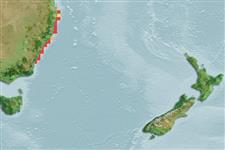>
Ovalentaria/misc (Various families in series Ovalentaria) >
Ambassidae (Asiatic glassfishes)
Etymology: Ambassis: Derived from Greek, anabasis = climbing up (Ref. 45335).
More on author: Macleay.
Environment: milieu / climate zone / depth range / distribution range
Écologie
marin; eau douce; saumâtre démersal; profondeur 0 - 6 m (Ref. 57178). Subtropical; 27°S - 36°S, 146°E - 155°E (Ref. 57342)
Southwest Pacific: Endemic to Australia.
Taille / Poids / Âge
Maturity: Lm ? range ? - ? cm
Max length : 7.0 cm SL mâle / non sexé; (Ref. 9002)
Épines dorsales (Total) : 8; Rayons mous dorsaux (Total) : 9 - 11; Épines anales: 3; Rayons mous anaux: 8 - 9; Vertèbres: 24. Adults have a single supraorbital spine, a short-based, deeply notched dorsal fin, and are transparent and silvery (Ref. 33616).
Occurs in lentic and lotic freshwater, as well as in mangrove areas (Ref. 7300). A small schooling species also found in estuaries and coastal marine waters (Ref. 33616).
Life cycle and mating behavior
Maturité | Reproduction | Frai | Œufs | Fécondité | Larves
Paxton, J.R., D.F. Hoese, G.R. Allen and J.E. Hanley, 1989. Pisces. Petromyzontidae to Carangidae. Zoological Catalogue of Australia, Vol. 7. Australian Government Publishing Service, Canberra, 665 p. (Ref. 7300)
Statut dans la liste rouge de l'IUCN (Ref. 130435: Version 2024-2)
Menace pour l'homme
Harmless
Utilisations par l'homme
Outils
Articles particuliers
Télécharger en XML
Sources Internet
Estimates based on models
Preferred temperature (Ref.
123201): 19.6 - 23.6, mean 21.8 °C (based on 24 cells).
Phylogenetic diversity index (Ref.
82804): PD
50 = 0.5000 [Uniqueness, from 0.5 = low to 2.0 = high].
Bayesian length-weight: a=0.01202 (0.00496 - 0.02912), b=3.02 (2.83 - 3.21), in cm total length, based on LWR estimates for this Genus-body shape (Ref.
93245).
Niveau trophique (Ref.
69278): 3.1 ±0.30 se; based on food items.
Résilience (Ref.
120179): Haut, temps minimum de doublement de population inférieur à 15 mois (Assuming Fec > 10,000).
Fishing Vulnerability (Ref.
59153): Low vulnerability (10 of 100).
Nutrients (Ref.
124155): Calcium = 374 [171, 1,142] mg/100g; Iron = 2.45 [1.21, 5.19] mg/100g; Protein = 18.6 [16.8, 20.3] %; Omega3 = 0.369 [0.184, 0.777] g/100g; Selenium = 12.9 [5.2, 31.3] μg/100g; VitaminA = 31.8 [9.9, 107.5] μg/100g; Zinc = 1.93 [1.19, 3.25] mg/100g (wet weight);
